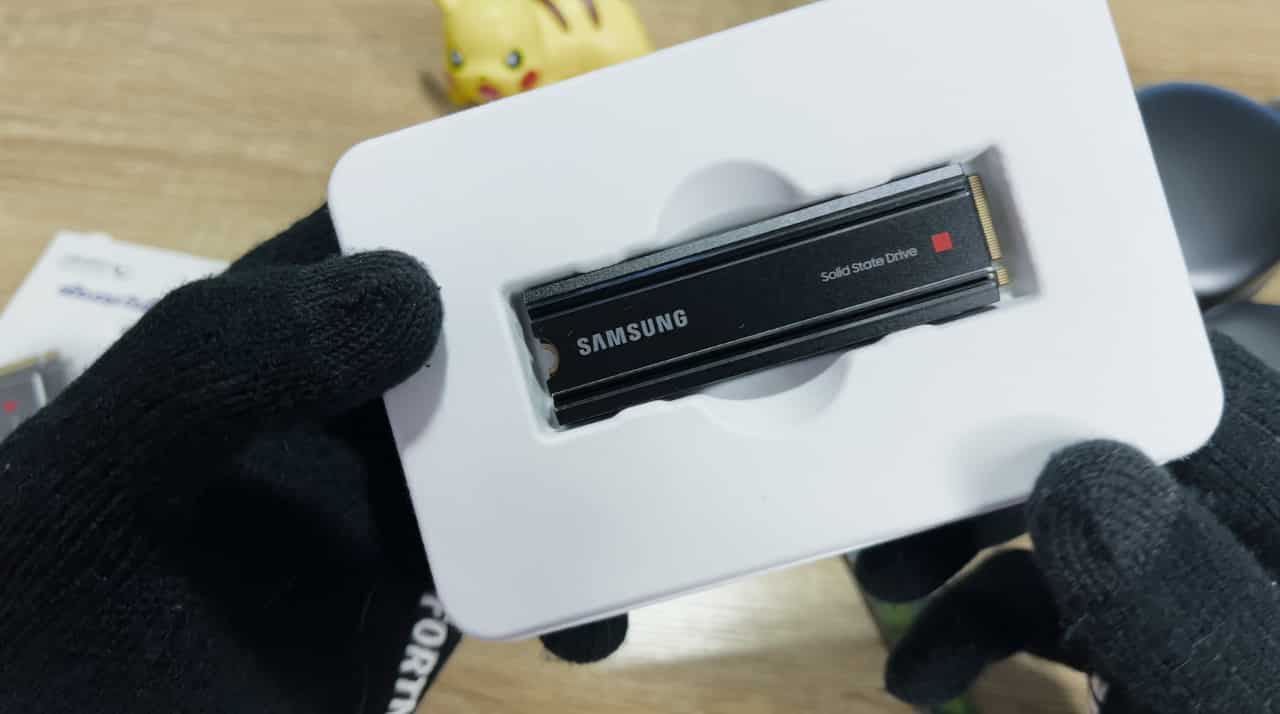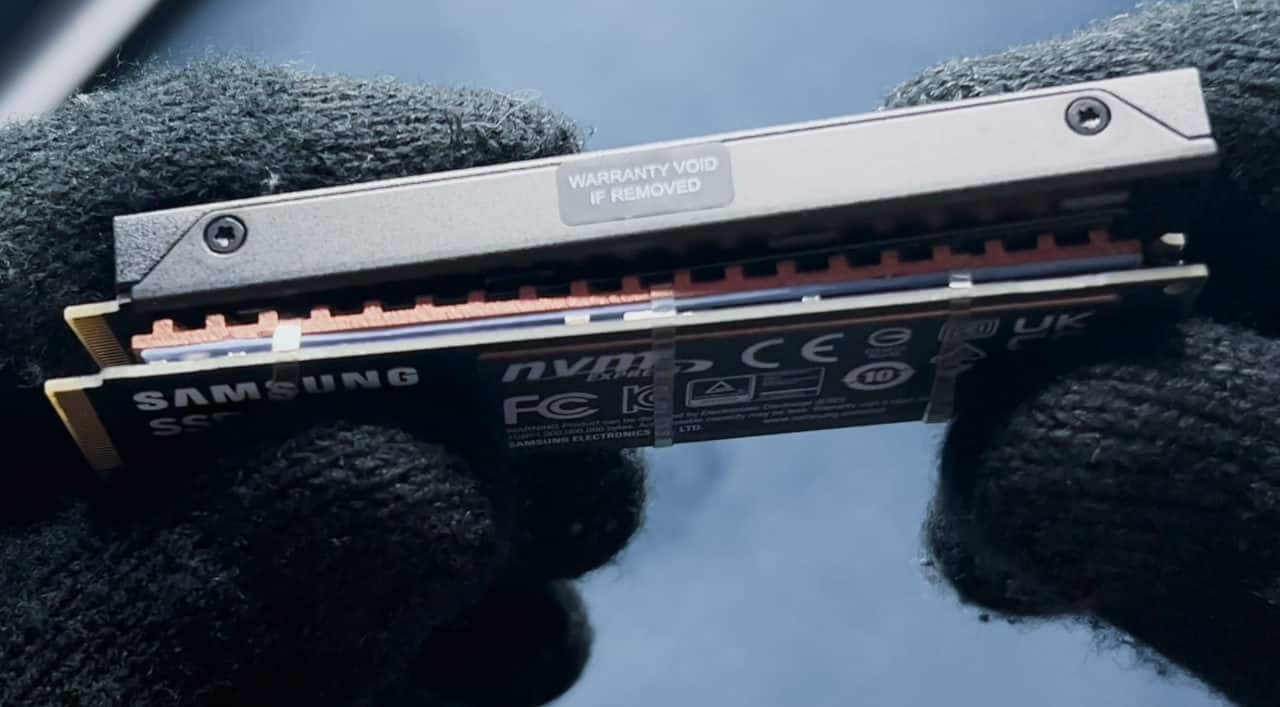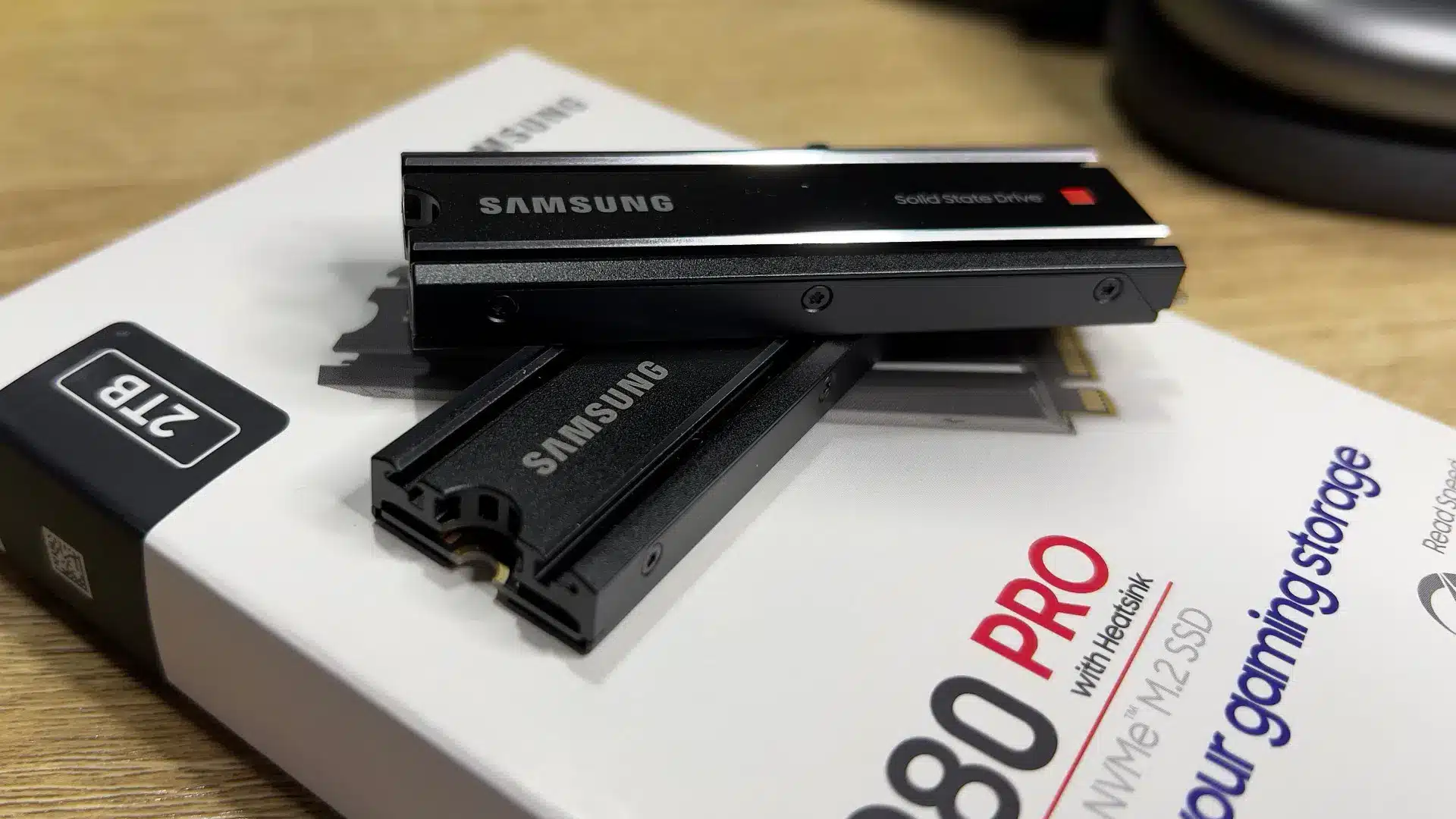Samsung has finally released the Samsung 980 Pro SSD with the heatsink in SA. To catch you up, back in October last year Sony released the PS5 update that unlocked the SSD slot in the console. While this was good news for gamers, it wasn’t the best news for South Africans. You see, no brand decided to prepare for this feature and import heatsink SSDs into the country. You could easily find compatible 7000MB/s SSDs but none of them had heatsinks. The Samsung 980 Pro was one of them.
Watch this entire breakdown and review in video form below
So back in October, we imported our own heatsink, which was really just a little piece of copper with a thermal pad tied to an SSD with some flimsy elastic bands. Regardless, it worked and it took the Samsung 980 Pro from being incompatible with the PS5 to being the perfect match for the console. In fact, I have been using that Samsung 980 Pro SSD since then and it hasn’t given me a day of trouble. Even when Eskom turns off my power because they can’t tell the difference between block 9 and block 4, the SSD repairs itself and things go back to normal.
Now for R500 more, South Africans can save themselves the hassle of firstly, trying to find a heatsink somewhere in this country and secondly, applying it. The Samsung 980 Pro with a heatsink is exactly the same SSD but it comes with the convenience of the heatsink already pre-installed. It is also a Samsung Heatsink so it is fancier and a lot more good looking than my piece of copper with a thermal pad tied together with some flimsy elastic bands.

But regardless of which model you get, you’ll still get the same incredible value across the SSD range and I am going to show you some tests to prove this. Samsung sent me both the 1TB and 2TB 980 with a heatsink to test out and I could not wait to open up my PS5 and install them.
I also wanted to test out some thermals between the heatsink model and the model I put my own heatsink on. It will be interesting to see whether or not the custom heatsink has any major difference from the other model.

Samsung 980 Pro Heatsink Design
Before we start with the tests, you need to see this Samsung 980 Pro with a heatsink in the flesh. The SSD is almost the exact same size as the custom heatsink model. It is, of course, an M.2 SSD that boasts the 2280 design. This means it complies with Sony’s SSD requirements to fit into the console’s expansion slot. I really like the design of the Samsung 980 Pro’s heatsink. Even if it is just a simple slate of metal.
You can see from the inside that Samsung has simply taken the original SSD and slid it into the heatsink casing. There is a bit of glue showing on the one end which is being used to hold it together. There’s also some thermal padding on the inside which is used to keep things cool and transfer the heat from the SSD to the metal plate. The SSD also doesn’t come out of the heatsink even if it looks like it can. The heatsink is also attached with some screws which makes this tough to get into. Samsung also doesn’t want you to remove the heatsink either. This is clear by the giant warranty warning sticker on the seal.

Installing the Samsung 980 Pro into the PS5 is as simple and easy as any other SSD you can get. You have to remove the PS5 faceplate by lifting the back corner of the plastic and tug the faceplate in the opposite direction. Once open, you should maybe clean inside because you probably haven’t in a while and should be ashamed of yourself.
Once done, unscrew the SSD cover to reveal the expansion slot. This Samsung 980 Pro is a 2280 SSD, so you’ll have to install it from the back-most slot. Loosen the screw in the spot that you need and slide the SSD into the slot. Once done correctly, you’ll notice the SSD will hang in the air like it is happy to see you. Push that bugger down and replace the screw back into the original slot.

Close the SSD case and slide the faceplate back onto your console. Once done, your SSD is now installed and ready to go. The first time you boot your PS5 up you’ll get the prompt that the SSD is installed and a speed test will show you bought the right SSD. After which, you’re good to go. I would suggest copying as much content off the PS5 SSD onto the Samsung SSD to avoid the internal storage fulling up. Especially if you make a lot of video recordings. It is always nice to have the PS5 SSD empty to save these.
As for the speeds, the Samsung 980 Pro doesn’t disappoint at all. I copied games to and from the PS5 storage and got the following results.
From PS5 SSD to Samsung
- Far Cry 6 (118GB) – 1m 39s
- Horizon Forbidden West (99GB) – 1m 17s
- Ghost of Tsushima (60GB) – 58s
Load Time Test on Samsung 980 Pro SSD
- Horizon Forbidden West to main menu – 18s
- Horizon Forbidden West to game – 8s
- Horizon Forbidden West fast travel – 4s
- Far Cry 6 to main menu – 46s
- Far Cry 6 to game – 9s
- Far Cry 6 fast travel – 8s
- Ghost of Tsushima to main menu – 22s
- Ghost of Tsushima to game – 2s
- Ghost of Tsushima fast travel 0.9s
From SSD to PS5
- Far Cry 6 (118GB) – 8m 32s
- Horizon Forbidden West (99GB) – 7m 9s
- Ghost of Tsushima (60GB) – 4m 21s

I was also really interested to see whether or not this Samsung 980 Pro SSD with the heatsink ran any hotter than the one with my heatsink on. So to do this, I copied two large games directly after one another and tested the temperature of the SSD case once the copying was complete. Now I know Sony has implemented this tech properly so the chances of any overheating are slim but for anyone out there wondering if there was a difference between a custom heatsink and this one, there is.
The tests showed that the custom heatsink model was a bit cooler than the pre-installed heatsink model and it makes complete sense. You see, the heatsink model comes with a double-sided piece of metal. It also packs its own custom nickel-coated controller. Whereas in the custom heatsink model, I only installed copper on one side.
So naturally, the model with the pre-installed heatsink would get warmer. This is firstly due to the difference in material and the nickel coating right near the bottom of the heatsink is able to absorb a lot more heat. It is also important to note that the area where this controller is was the warmest measuring 43 degrees celsius.
Does it make a difference? Not really. In order to see any real throttling taking place on an SSD, it has to reach temperatures of 85 degrees celsius and up. This isn’t anywhere close to that. So while the heatsink model is a bit warmer, it still performs just as well as the other one. Regardless, you need a heatsink here so either route you go is great.
Samsung 980 Pro With Heatsink
- Samsung 980 Pro PS5 SSD area while closed – 22C
- Samsung 980 Pro heatsink exposed – 43C
- Custom heatsink area while closed – 21C
- Custom heatsink exposed – 33C
Regardless of the increased heat, the Samsung 980 Pro SSD is a champion with a heatsink or without. If you want to get the hassle-free version, the heatsink model is your go-to but there’s honestly nothing wrong with doing it yourself too. The SSD performs perfectly either way and that’s thanks to its incredible engineering.

Once again shoutout to Samsung for sending these units through to me to test. You can pick the 1TB model up for R4,999 and the 2TB model for R9,499. The heatsink free models cost R8,999 for the 2TB and R4,499 for the 1TB model.

